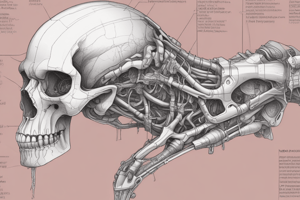Podcast
Questions and Answers
What is a Condyle?
What is a Condyle?
- Opening or hole on bone
- Rounded, knuckle-like process (correct)
- Sharp projection
- Large rounded projection
What is a Crest?
What is a Crest?
- Cleft or deep groove
- Prominent ridge (correct)
- Tube or passageway
- Pit or hollow
What is the Head of a bone?
What is the Head of a bone?
- Bony prominence
- Small rounded projection
- Enlargement at one end of the bone (correct)
- Opening or hole on bone
What is a Process?
What is a Process?
What does a Spine refer to in anatomical terms?
What does a Spine refer to in anatomical terms?
What is a Tubercle?
What is a Tubercle?
What is a Tuberosity?
What is a Tuberosity?
What is a Fissure?
What is a Fissure?
What is a Foramen?
What is a Foramen?
What is a Fossa?
What is a Fossa?
What does Meatus refer to?
What does Meatus refer to?
What is a Sinus in anatomical terms?
What is a Sinus in anatomical terms?
What is a Sulcus?
What is a Sulcus?
Study Notes
Elevations
- Condyle: Rounded, knuckle-like process found at articulating joints, allows movement between bones (e.g., mandibular condyle).
- Crest: Prominent ridge along the bone's surface, serves as a site for muscle attachment (e.g., iliac crest).
- Head: Enlarged, rounded portion at one end of a bone, important for forming joints (e.g., head of the femur).
- Process: A bony prominence that often serves as a point of muscle attachment (e.g., mastoid process).
- Spine: Sharp, slender projection from the bone, typically where ligaments or tendons attach (e.g., spine of the scapula).
- Tubercle: Small, rounded projection that serves various functions, including muscle attachment (e.g., articulate tubercle).
- Tuberosity: Larger, rounded projection that provides support for muscles and tendons (e.g., calcaneal tuberosity).
Depressions
- Fissure: Narrow cleft or deep groove within a bone, often where nerves or blood vessels pass.
- Foramen: A round or oval opening in a bone allowing for the passage of nerves and blood vessels (e.g., foramen magnum connects spinal cord to brain).
- Fossa: A pit or hollow area in a bone, often serving as a space for muscles or articulating joints (e.g., mandibular fossa).
- Meatus: A tube-like passageway, usually found in the skull; plays a role in auditory functions (e.g., external auditory meatus).
- Sinus: A cavity within a bone, typically filled with air, that can impact weight and resonance (e.g., frontal sinus).
- Sulcus: A groove or furrow, larger than a fissure; facilitates movement or accommodates structures (e.g., precentral sulcus).
Studying That Suits You
Use AI to generate personalized quizzes and flashcards to suit your learning preferences.
Description
Test your knowledge of anatomical terms related to elevations and depressions in bones with these flashcards. Each term is defined, supported by examples, to enhance your understanding of the human skeletal system. Perfect for A&P students looking to strengthen their vocabulary.





